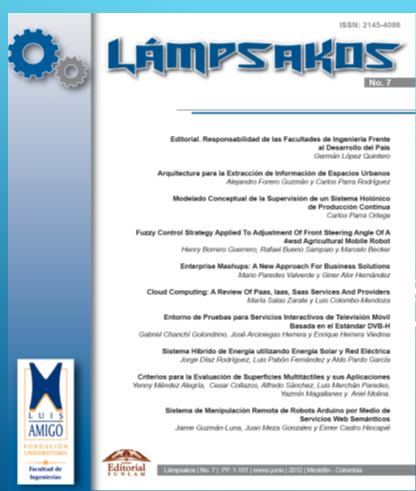Fuzzy Control Strategy Applied to Adjustment of Front Steering Angle of a 4WSD Agricultural Mobile Robot
DOI:
https://doi.org/10.21501/21454086.842Keywords:
Ackerman geometry, fuzzy controller, Two-Track Vehicle, Lateral dynamics, mobile robot, bike model, steering angle.Abstract
This paper presents the preliminary studies of the control strategy based in fuzzy logic, projected for the steering system of AGRIBOT project that consist of a wheeled autonomous mobile robotic in real scale endowed with four independent steering and driven wheels (4WSD). In this work we present a preliminary fuzzy controller design applied to front steering angle, using a multivariable plant which incorporates simplified linear model of lateral dynamics of a vehicle whose input are linear combination of rear and front steering angles. The fuzzy control strategy was decided because provides flexible way to deploy with embedded systems. Simulations are used to illustrate the designed controller performance. We use Ackerman geometry to trace front steering angle that allows the vehicle to perform correctly a given maneuver preserving a minimum level of stability and maneuverability. The goal is to establish a relationship between steering input commands and the control commands to the actuators so that it is possible to adjust the attitude of the actuators over the movement axis, as the trajectory change.Downloads
References
Heraud, J., Lange, A., 2009, “Agricultural Automatic Vehicle Guidance from Horses to GPS: How We Got Here, and Where We Are Going”, ASABE Distinguished Lecture #33, pp. 1-67, Agricultural Equipment Technology Conference February 8-11, Louisville, Kentucky, USA.
Sigrimis, N., Antsaklis, P., Groumpos, P.P.,2010, “Advances in control of agriculture and the environment,” Control Systems, IEEE , vol.21, no.5, pp.8-12, Oct 2001.Singapore.
UNIBOTS., http://www.unibots.com/Agricultural_ Robotics_Portal.htm, accesed in Jan. 2011.
Bak, T., Jakobsen, H., 2009 “Agricultural Robotic Platform with Four Wheel Steering for Weed Detection”, Biosystems Engineering, Volume 87, Issue 2, February 2004, Pages 125-136.
Bakker, T. “An autonomous robot for weed control”, design, navigation and control”, PhD thesis - Wageningen University.
Tangerino, G., Godoy, E., Tabile, R., Souza, R., Inamasu, R., 2011, “Controle de Esterçamento de Robô Agrícola Móvel de Quatro Rodas Guiáveis”, X Simpósio Brasileiro de Automação Inteligente (SBAI).
Vilaplana, M., Leith, D., Leithead, W., Kalkkuhl, J, 2003, “Control of Sideslip and Yaw Rate in 4-Wheel Steering Cars Using Partial Decoupling and Individual Channel Design”, Proceedings of the European Control Conference 2003, 1-4 September 2003,Cambridge, UK. The IEE.
Rajamani, R., 2005 “Vehicle Dynamics and Control”, Springer-Verlag, 2005.
Manning, J., Crolla, D., 2007, “A review of Yaw Rate and Sideslip Controllers for Passenger Vehicles”, Transactions of the institute of measurement and control, pp. 117–135.
Sivanandam, S., Sumathi., Deepa, S., 2007, “Introduction to Fuzzy Logic using MATLAB”, Springer-Verlag Berlin Heidelberg.
Hakima, A., Ameli, S., 2010, “ Designing a Fuzzy Logic Controller to Adjust theAngle of Tires in Four Wheel Steering Vehicles”, 2010 11th Int. Conf. Control, Automation, Robotics and Vision, Singapure.
Zhang, J., Zhang Y., Chen L., Yang J., 2007 , “A fuzzy control strategy and optimization for four wheel steering system,” Vehicular Electronics and Safety, 2007. ICVES. IEEE International Conference on , vol., no., pp.1-6, URL: http:// ieeexplore.ieee.org/stamp/stamp.jsp?tp=&arnu mber=4456359&isnumber=4456353.
Downloads
Published
How to Cite
Issue
Section
License
In accordance with national and international copyrights, as well as publishing policies of "Fundación Universitaria Luis Amigó" and its Journal "Lámpsakos" (indexed with ISSN : 2145-4086), I (we ) hereby manifest:1. The desire to participate as writers and submit to the rules established by the magazine publishers.
2. The commitment not to withdraw the manuscript until the journal finishes the editing process of the ongoing issue.
3. That article is original and unpublished and has not been nominated or submitted together in another magazine; therefore, the rights of the article in evaluation have not been assigned in advance and they do not weigh any lien or limitation for use.
4. The absence of conflict of interest with commercial institution or association of any kind
5. The incorporation of the quotes and references from other authors, tending to avoid plagiarism. Accordingly, the author affirms that the paper being published do not violate copyright, intellectual property or privacy rights of third parties. Morover, if necessary there is a way of demonstrating the respective permits original copyright to the aspects or elements taken from other documents such as texts of more than 500 words, tables, graphs, among others. In the event of any claim or action by a third party regarding copyright on the article, the author (s) will assume full responsibility and come out in defense of the rights herein assigned. Therefore, for all purposes, the Journal "Lámpsakos" of the "Fundación Universitaria Luis Amigó" acts as a third party in good faith.
6. In the event of the publication of the article, the authors free of charge and on an exclusive basis the integrity of the economic rights and the right to print, reprint and reproduction in any form and medium, without any limitation as to territory is concerned, in favor of the Journal "Lámpsakos" of the "Fundación Universitaria Luis Amigó".








